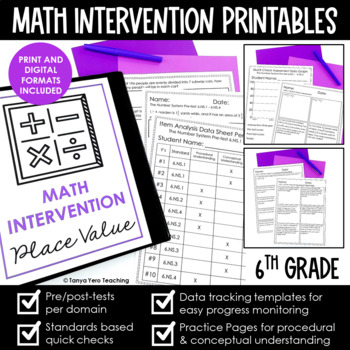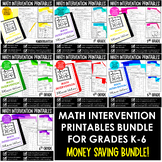Math Intervention 6th Grade Binder Yearlong RTI Progress Monitoring Bundle
- Zip
- Google Apps™

What educators are saying
Products in this Bundle (6)
showing 1-5 of 6 products
Bonus
Also included in
- A comprehensive, no prep, standards-based bundle of RTI math intervention resources for grades 6-8. This research-based intervention bundle includes tools for building a systematic, data-driven intervention process.With pre/post-tests (for each domain) for executing screening, quick checks for progrPrice $105.00Original Price $133.50Save $28.50
- A comprehensive, no prep, standards-based bundle of RTI math intervention resources for grades K-8. This research-based intervention bundle includes tools for building a systematic, data-driven intervention process.With pre/post-tests (for each domain) for executing screening, quick checks for progrPrice $299.00Original Price $395.00Save $96.00
- A comprehensive, no prep, standards-based bundle of RTI math intervention resources for grades K-6. This research-based intervention bundle includes tools for building a systematic, data-driven intervention process.With pre/post-tests (for each domain) for executing screening, quick checks for progrPrice $225.00Original Price $308.00Save $83.00
Description
A comprehensive, no prep, standards-based bundle of RTI 6th grade math intervention resources. This research-based intervention bundle includes tools for building a systematic, data-driven intervention process.
With pre/post-tests (for each domain) for executing screening, quick checks for progress monitoring, practice pages for guided and independent practice and data tracking forms, this math intervention kit will organize and transform your intervention instruction.
Finding the time in your math block to provide RTI math intervention services to students is difficult. This 6th grade intervention bundle saves you time by assembling all of the resources you need in one complete bundle for 6th grade. No more searching for the right resources and patching them together.
This progress monitoring bundle contains 5 intervention sets for each domain for 6th grade math- all standards included!
Here is what you get for each domain:
- Pre/Post Tests for each domain including item analysis for each assessment
- Quick checks for each standard
- Practice pages for each standard—segmented by procedural and conceptual understanding
- Procedural and conceptual questioning
- Progress monitoring graphing forms
- Excel RTI graphing pack
- Print (PDF) and digital versions (made within Google Slides)
---------------------------------------------------------------------------------------------------------
Each set contains the resources you need to precisely target student needs, close gaps, progress monitor and produce visual representations of intervention data as you deliver your instruction.
Use these materials to make data-driven decisions for intervention students and as preventative maintenance for your whole class.
Hyper-targeting is very important in providing intervention services and we include an item analysis with each pre-test and post-test so you can identify exactly which skills need extra support.
Procedural and conceptual questioning are included and identified so you can zero in on each students' strengths and weaknesses. Research-based principles are used in this resource and an explanation page is included if you need documentation of such for administration. Data tools for progress monitoring are included as well, including a digital Excel file for easy creation of professional looking graphs.
Take the guess work out of providing intervention and focus on what you do best…delivering quality instruction to your students!
Standards & Topics Covered:
Ratios and Proportional Relationships
- 6.RP.1 – Understanding ratios
- 6.RP.2 –Understanding unit rates associated with a ratio
- 6.RP.3 – Use ratio and rate reasoning to solve real world problems
The Number System
- 6.NS.1 - Interpreting and commuting quotients of fractions
- 6.NS.2 – Fluently divide multi-digits numbers
- 6.NS.3 – Fluently add, subtract, multiply, and divide
- 6.NS.4 – Finding the greatest common factor of two numbers
- 6.NS.5 – Understanding positive and negative numbers
- 6.NS.6 – Understanding a rational number as a point on a number line
- 6.NS.7 – Ordering absolute value of rational numbers
- 6.NS.8 – Solve real world problems by graphing points on a coordinate plane
Expressions and Equations
- 6.EE.1 – Write and evaluate numerical expressions involving exponents
- 6.EE.2 – Write, read, and evaluate expressions using variables
- 6.EE.3 - Apply the properties of operations to generate equivalent expressions.
- 6.EE.4 - Identify when two expressions are equivalent
- 6.EE.5 - Understand solving an equation or inequality as a process of answering a question
- 6.EE.6 - Use variables to represent numbers and write expressions when solving a real-world or mathematical problem
- 6.EE.7 - Solve real-world and mathematical problems by writing and solving equations
- 6.EE.8 – Writing inequalities
- 6.EE.9 – Using variables to represent two quantities in real world problems
Geometry
- 6.G.1 – Finding area of triangles
- 6.G.2 – Finding volume of prisms with fractional length amounts
- 6.G.3 – Drawing polygons on a coordinate plane
- 6.G.4 - Represent three-dimensional figures using nets made up of rectangles and triangles
Statistics and Probability
- 6.SP.1 – Recognize statistical questions
- 6.SP.2 - Understand that a set of data collected to answer a statistical question has a distribution
- 6.SP.3 – Measuring the center of data
- 6.SP.4 - Display numerical data in plots on a number line, including dot plots, histograms, and box plots
- 6.SP.5 – Summarize numerical data sets








